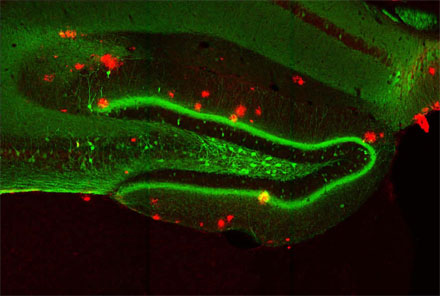An experimental optogenetics technique has been applied to a mouse model of Alzheimer’s disease (AD) to rescue memories. The study revealed that spines — small knobs on brain-cell dendrites through which synaptic connections are formed — are essential for memory retrieval and that fiber optic light stimulation could be used to regrow lost spines, enabling the mice to remember a previous experience.
Researchers from the Massachusetts Institute of Technology’s Riken Center for Neural Circuit Genetics reported that through repeated stimulation with high-frequency bursts of light to the hippocampal memory circuit in AD mice, they boosted the number of spines to levels indistinguishable from those in control mice. The freezing behavior in the trained task also returned and remained for up to six days.
"We have shown for the first time that increasing synaptic connectivity within engram cell circuits can be used to treat memory loss in mouse models of early Alzheimer's disease," said MIT Ph.D. candidate Dheeraj Roy.

A representation of the coronal section of hippocampal dentate gyrus (DG) from a mouse model of early Alzheimer's disease (AD). These AD mice exhibit severe ß-amyloid plaques (red) in the DG at 9 months of age. Using these mice combined with a novel viral strategy, memory engram cells (green) for a contextual fear memory were labeled. Courtesy of Riken.
In the study, the mouse memory was inferred from learned behavior — associating an unpleasant foot-shock with a particular cage. Remembering and expecting shocks caused the mice to freeze in the particular enclosure but not in a neutral one. Compared with normal mice, AD mice exhibited amnesia and reduced freezing behavior, indicating progressive memory loss, the researchers said.
The engrams, or memory traces, of the foot-shock experience were known to be located in the dentate gyrus (DG) of the hippocampus, a key brain area for memory processing. During fear conditioning, researchers used a virus to deliver a gene into the DG, which labeled active engram cells, allowing visual identification of the neurons that made up the engram for that specific fear memory.
A second virus contained a gene making only these engram neurons light-sensitive. When the engram cells were reactivated with light in the AD mice, memory of the foot-shock experience became retrievable, and freezing behavior was restored.
The restored memories faded within a day, and the researchers next sought to understand why this happens. They noted a reduction in the number of spines as the mice aged and their AD progressed, that the waning fear memory corresponded to a loss of spines.
Previous work had shown that spines grow when neurons undergo long-term potentiation, a persistent strengthening of synaptic connectivity that happens naturally in the brain but can also be artificially induced through stimulation.
Through repeated stimulation with high-frequency bursts of light to the hippocampal memory circuit in AD mice, the team was able to boost the number of spines to levels indistinguishable from those in control mice. The freezing behavior in the trained task also returned and remained for up to six days. The implication is that restoring lost spines in the hippocampal circuit facilitated retrieval of the specific fear experience and its associated freezing behavior.
Light stimulation did not boost the number of spines in normal mice or strengthen the fear memory, nor did indiscriminately shining light in the DG result in any long-term memory improvement. Only the precise stimulation of engram cells was able to increase the number of spines and bring about the memory improvement in AD mice.
The researchers said the results suggest that impaired retrieval of memories, rather than poor storage or encoding, may underlie this prominent symptom of early Alzheimer's disease and points to the synaptic connectivity between memory cells as being crucial for retrieval.
The work was published in Nature (doi: 10.1038/nature17172).